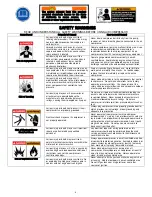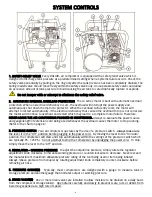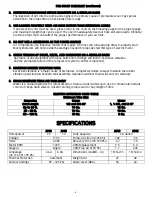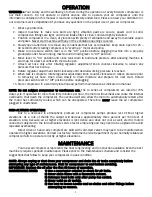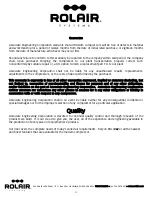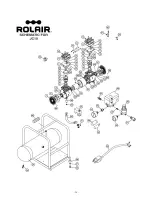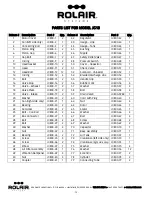
- 9 -
OPERATION
WARNING – Your safety and the wellbeing of others during the operation of every ROLAIR
®
compressor is
our main concern. Do not operate or permit anyone else to operate your air compressor until the
information contained in this manual is read and completely understood. Please contact your distributor or
our customer service department if you have any questions on the proper use of your air compressor.
1.
Wear eye protection.
2.
Inspect machine to make sure bolts are tight, vibration pads are secure, power cord is solid,
compression fittings are tight, and the air intake filter is clean, solid and tightly installed.
3.
Position compressor in a clean, dry location with plenty of ventilation and away from volatile vapors
and gases. Never start machine with any of the ventilation openings covered.
4.
Slowly open tank drain to remove any condensate that has accumulated. Keep drain open for 20 –
30 seconds after starting compressor to “warm-up” motor and pump.
5.
Make sure pressure switch lever is in the “Off” position before plugging machine into a properly
grounded outlet. Never unplug machine until moving lever to “Off” position.
6.
Move lever to “On” position and close tank drain to build tank pressure after allowing machine to
warm up for a few seconds with the drain open.
7.
Attach air hose only after rotating regulator adjustment knob counter-clockwise to relieve any
pressure that has built up.
8.
Rotate regulator adjustment knob clockwise until desired working pressure is reached.
9.
When task is complete, rotate regulator adjustment knob counter-clockwise to relieve pressure prior
to removing air hose. Open drain slowly to drain moisture and prepare for next start. Rotate
pressure switch lever to “Off” position before unplugging.
10.
Store compressor in a warm/dry location and perform maintenance as indicated in manual.
NOTE: Do not subject compressor to continuous use. The JC series air compressors are rated for 70%
duty-cycle. If operated for more than forty minutes per hour, the motor will overheat and cause the internal
overload to shut down the compressor. The overload will also allow the motor to automatically restart after
the motor has sufficiently cooled, which can be unexpected. Therefore, never leave the air compressor
plugged in unattended.
HIGH-ALTITUDE OPERATION:
Due to a decrease in atmospheric pressure air compressor pumps produce less CFM at higher
elevations. As a rule of thumb the output will decrease approximately three percent per 1000 feet of
elevation. Also, because air at higher elevations is less dense and does not cool as well, electric motors
cannot be subjected to the full nameplate service factor amp rating and may need to be upgraded to avoid
repeated overheating.
Direct drive or hand-carry compressors built with cold-start valves may need to be modified when
operated in higher elevations. Contact our factory Customer Service Department if your normally reliable air
compressor fails to operate correctly at higher elevations.
MAINTENANCE
Your new air compressor represents the finest engineering and construction available. Even the best
machinery requires periodic maintenance. Please stick to the maintenance schedule and consider the
suggestions that follow to keep your compressor in peak condition.
NOTE: Always unplug or shut down your compressor and drain the air tanks completely before
attempting any type of maintenance. Wait for compressor to cool before servicing.
IMPORTANT: Replace the oil after the first 50 hours of operation.
MAINTENANCE HINTS:
1) Use a soap/water solution to check for air leaks.
2) Never clean filters with a flammable solvent.
3) Retorque head bolts only after pump has cooled.
4) Never weld on air tank(s).
5) Use heat to loosen Loctite seal on drains and other fittings before
attempting to remove.
Summary of Contents for JC10
Page 12: ... 12 ...
Page 14: ... 14 ...




